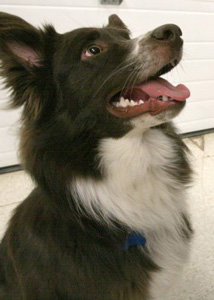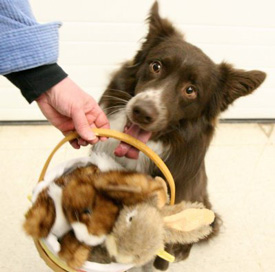Unexpected trouble
A few weeks ago, I gave a short teaching demonstration for a Karen Pryor Academy workshop. The lesson had me teaching students to train their dogs to target to the students' index fingers and then follow the finger. It's a handy behavior that can be used to teach heeling or any number of great tricks. I looked forward to teaching it, as it's one of my favorites.

photo by Robin Tinay Sallie
After I had started my lesson, with confidence I led my 16-month-old puppy, Finn, out of his crate. Finn would demonstrate what the finished behavior looked like. He is terrific at this exercise, and we had practiced the behavior perfectly in the hotel room earlier in the day.
However, this time when I pointed my index finger and cued "touch," Finn gave me a blank look. "Touch," I cued again. Nothing. He looked away, not even interested in the treats I held in my clicker hand. I tried to capture the behavior by clicking and treating it to demonstrate how we had trained it. But instead of sniffing my finger, or even looking interested in the prospect of earning a treat, he gave me another blank look. For whatever reason, Finn's mind was elsewhere that morning.
Moving right along...
I only had 20 minutes to teach my students, so I asked a classmate to lead Finn to his crate in another room, where he wouldn't be stressed by my working with other dogs. I continued with my lesson, pretending that my right fist was the dog targeting to my left finger. Oh, for a sock puppet...
During the mid-afternoon break, my class held a lively discussion about what happens when your demonstration dog can't do the behavior. Or—as happened in my lesson—when your demo dog can't do much of anything and is led away. Would students conclude that clicker training is an inferior training method? On the 9-hour drive home, I thought a lot about that question and kept coming back to something I learned a long time ago.
When I was the student
Thirty years ago in Fort Collins, Colorado, I brought my Australian shepherd rescue dog, Cowboy, to a beginning obedience class taught by a woman named Barbara Handler. People who know me well have heard me talk about Barb and the influence she had on me as a trainer. Obedience aficionados may have read one of her books on positive dog training and handling in the obedience ring.
Although she was not a clicker trainer, Barb was one of the top obedience competitors in the Rocky Mountain region. She trained the first sheltie in Colorado to be awarded a UDT (Utility Dog Tracker) title. Her demonstration dog at the time was a Belgian Tervuren, a dog with profound shyness issues. Despite his temperament challenges, he had earned the titles of Conformation Champion, Obedience Trial Champion, Utility Dog, and Tracking Dog (Ch, OTCH, UDT)—huge accomplishments for any dog.
Barb's classes always included a short lecture. In her beginning classes, these lectures focused on topics such as house training and the importance of spaying and neutering a pet. She used her Belgian Tervuren as an example: despite his many titles, he was not breeding quality because of his shy temperament. He was neutered just after he finished as a champion, and he was never bred.

photo by Robin Tinay Sallie
Barb illustrated these lectures, and often her obedience lessons, with stories about dogs she or her friends in the obedience circle had owned or trained. She had an acerbic wit, and her stories were punctuated with humor and humility. She'd laugh as she talked about the foibles of dogs and of herself. Barbara warned us that if we expected perfection, then we should consider another sport because dogs are no more perfect than we are. And yet, there she was, competing and judging all around the country, earning armloads of ribbons and titles.
Often Barb spoke about the challenges of training and showing a dog like "Toons," as she affectionately called him (short for his other nickname, "Loony Toons"). She explained that no matter how much training a dog has, winning is sometimes a matter of strategy. For example, Barb knew that a dog like her Toons could never be shown under a male judge; the dog would not allow a strange man to touch him.
What is the lesson?
What does this have to do with my demo dog not being able to demo? Well, if my lesson had been a traditional 50-minute class, Finn's blank look would have been the starting point of a talk like Barb used to give. I only hope I'd be able to pepper it with as much humor as she would have.
The crux of this short talk would have been the importance of empathy, and of bonding with the animals we choose to bring into our lives. Perhaps I'd talk about how difficult it had been to bond with Finn, and how I was unwilling to risk that bond by "forcing" him to perform. I might have discussed the occasional frustration we all have while training dogs, and how to handle training sessions that don't seem to be going well. Finn's refusal would have made a perfect starting point for a discussion about why punishment is never an appropriate option.
Or, the discussion might have been about how a trained dog doesn't just appear overnight. Finally, we might have chatted about what to expect with a teenage dog, as many people come to their first class with teenage dogs.
Underlying opportunity
What Barb taught me is that instructors have an incredible opportunity to mentor their students, not just as dog trainers, but as dog owners. Not just to teach, but to lead by example. When something goes wrong with a training demonstration, it opens up a tremendous learning opportunity; sometimes we learn more by what goes wrong than by what went perfectly.
New students and new dog owners often have unrealistic expectations of how young dogs should behave or of the time it takes to teach dogs a set of house- or family-friendly behaviors. Teaching students how to use the clicker to shape a puppy's behavior, instructors also have the opportunity to shape students' expectations in a way that promotes empathy and compassion. When our own dog doesn't "perform" in class, we have the perfect opening for that conversation and lesson.
Sadly, Barb passed away in 2005. Although I haven't taken a class from her in more than 25 years, I am still thankful to have had her as my first instructor. I believe our ears are open the most with our first instructors. All of us who train and teach need to remember the influence we can have on an owner, a student, and even a family.
Readying Finn—and me—for the next time
It's clear that I need to do more training with Finn to prepare him for helping me with training demonstrations. In hindsight, a number of new criteria could easily have thrown him off at the Karen Pryor Academy lesson: working in front of an audience, working immediately after I led him out of his crate, and working in a training facility are three that come to mind. My job now is to practice these situations with him and to help him be ready to respond to my cues the next time I ask him to do a class demonstration.
Since Finn is a living, breathing creatures with a mind of his own, even with extra preparation and planning there still might be a time when a training demonstration doesn't go as intended. I'm prepared for that, and hope I'll also be ready to demonstrate what might be a far more valuable lesson.



What a great story!
Thanks for sharing your freestyle story. I think a lot of owners are afraid and embarrassed by what their dogs will do in class or out in public. How lucky they were to see a terrific demonstration by your student. Kudos to him -- and to you as well for providing such a supportive class atmosphere.
Thanks again,
-Jane
Oh that is so true that
Oh that is so true that students can learn alot when things go wrong and that we owe dogs to give good exemples of how to be dog owners!
I was very surprised the first time I heard a freestyle student tell me that she signed up for the class after seeing a demonmstration of some of my students. She said she was particulary moved by one beginner owner, a guy in his twenties, with his beginning adolescent dog , who started suddently running in circles in the middle of the performence. My students are well warned that it may happen the first times and what to do. That woman told me she was very moved by the fact that the young owner, even if feeling embarassed before the audience, did not get mad or irritated at his dog, and took all the time he had to to win her back, how the other students helped him catch the running dog, put her on leash, and how he asked his dog then to give him paw and rewarded her before ending it there. She said she wanted to be part of a school where people are so nice to their dogs and supportive to each other. I later learned that half of that class' students remembered well that crazy spinning adolescent Cane Corso with his young patient owner who surprised the public by his gentelness. I couldn't wait to tell that one student that his great exemple of what to do when things go wrong got us more freestyle students enrolled and inspired that day then all the other perfect presentations!
Post new comment